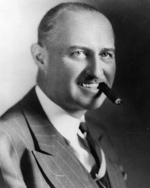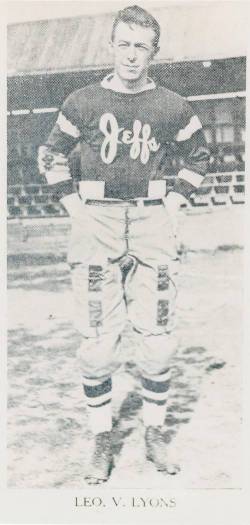Related Research Articles
Buffalo, New York had a turbulent, early-era National Football League team that operated under multiple names and several different owners between the 1910s and 1920s. The early NFL-era franchise was variously called the Buffalo All-Stars from 1915 to 1917, Buffalo Niagaras in 1918, the Buffalo Prospects in 1919, Buffalo All-Americans from 1920 to 1923, Buffalo Bisons from 1924 to 1925 and in 1927 and 1929, and the Buffalo Rangers in 1926. The franchise, which was experiencing financial problems in 1928, did not participate in league play that season.
The Tonawanda Kardex was an American football team active between 1916 and 1921. It played its games in Tonawanda, New York, a suburb of Buffalo with close ties to North Tonawanda, New York where American Kardex was founded. The team is most notable for its one game as a member of the American Professional Football Association in the 1921 season. They are easily the shortest-lived team in the league's history, and the shortest-lived known team in North American major league sports history.

The Rock Island Independents were a professional American football team, based in Rock Island, Illinois, from 1907 to 1926. The Independents were a founding National Football League franchise. They hosted what has been retrospectively designated the first National Football League game on September 26, 1920 at Douglas Park. The Independents were founded in 1907 by Demetrius Clements as an independent football club. Hence, the team was named the "Independents."
The 1920 APFA season was the inaugural season of the American Professional Football Association, renamed the National Football League in 1922. An agreement to form a league was made by four independent teams from Ohio on August 20, 1920, at Ralph Hay's office in Canton, Ohio, with plans to invite owners of more teams for a second meeting on September 17, 1920. The "American Professional Football Conference" (APFC) was made up of Hay's Canton Bulldogs, Akron Pros, the Cleveland Tigers and the Dayton Triangles, who decided on a six-game schedule to play each other at home-and-away, an agreement to respect each other's player contracts, and to take a stand against signing college students whose class had not yet graduated.

Wilbur Francis "Pete" Henry was an American football player, coach, and athletic administrator. He was a charter inductee into both the College Football Hall of Fame in 1951 and the Pro Football Hall of Fame in 1963.

Benjamin Lee Boynton, a.k.a. "The Purple Streak", was a professional football player who played during the early years of the National Football League. He was elected to the College Football Hall of Fame in 1962. He played in the NFL for the Washington Senators, Rochester Jeffersons and Buffalo Bisons.
A nameless professional American football team, based in Syracuse, New York and generically known as the Syracuse Pros or Syracuse Eleven, was once thought to have joined the American Professional Football Association (now the National Football League for the 1921 season. The team was coached by Mike Purdy and managed by Andy Friedman. Syracuse University multi-sport standout John Barsha was the team's franchise player.
The 1920 Buffalo All-Americans season was the franchise's inaugural season with the American Professional Football Association (APFA), an American football league, and fifth total as a team. The All-Americans entered 1920 coming off a 9–1–1 record in 1919 as the Buffalo Prospects in the New York Pro Football League (NYPFL). Several representatives from another professional football league, the Ohio League, wanted to form a new national league, and thus the APFA was created.

The 1920 Canton Bulldogs season was the franchise's sixteenth and its first in the American Professional Football Association (APFA), which became the National Football League two years later. Jim Thorpe, the APFA's president, was Canton's coach and a back who played on the team. The Bulldogs entered the season coming off a 9–0–1 performance as Ohio League champions in 1919. The team opened the season with a 48–0 victory over the Pitcairn Quakers, and finished with a 7–4–2 record, taking eighth place in the 14-team APFA. A then-record crowd of 17,000 fans watched Canton's week 12 game against Union AA of Phoenixville.
The 1920 Cleveland Tigers season was the franchise's inaugural season in the American Professional Football Association (APFA) and fifth total as an American football team. The Tigers entered the season coming off a 5-win, 2-loss, 2-tie (5–2–2) record in 1919. After the 1919 season, several representatives from the Ohio League, a loose organization of professional football teams, wanted to form a new professional league; thus, the APFA was created.
The 1920 Rochester Jeffersons season was the franchise's inaugural season in the American Professional Football Association (APFA) and thirteenth as an American football team. The Jeffersons entered 1920 coming off a six-win, two-loss, two-tie (6–2–2) record in the New York Pro Football League (NYPFL) where it lost the championship game to the Buffalo Prospects. Several representatives from another professional football league, the Ohio League, wanted to form a new national league, and thus the APFA was created.
The New York Pro Football League (NYPFL) was a professional American football league, active in the 1910s, and based in upstate New York, primarily Western New York. Between 1920 and 1921, the league's best teams were absorbed into the National Football League, though none survive in that league. It was one of the biggest challengers to the Ohio League in professional football in the 1910s.
Guilford W. "Hawk" Falcon was a professional American football player, owner and coach who spent six season, from 1920 to 1925, in the National Football League (NFL) with the Akron Pros, Canton Bulldogs, Chicago Tigers, Hammond Pros, Rochester Jeffersons and the Toledo Maroons. Guil also served a player-coach during his time with the Tigers and Maroons.

Ralph Edward Hay was the owner of the Canton Bulldogs from 1918 through the 1922 season. However, he is mostly recognized for organizing the first meeting of teams that would later form the American Professional Football Association, later called the National Football League.

Leo V. Lyons was a co-founder of the National Football League. He was a player, manager, coach and owner of the Rochester Jeffersons from 1908 to 1925.
Christopher O'Brien was a Chicago, Illinois house painter and plumber who became a pro football franchise owner. He is mostly known as the owner of the Chicago Cardinals, and has been called the "Father of Professional Football in Chicago". O'Brien was also a co-founder of the American Professional Football Association by representing the Cardinals at the September 17, 1920, league meeting at Ralph Hay's Hupmobile dealership in Canton, Ohio.

Douglas Park is a public park located at 18th Avenue and 10th Street in Rock Island, Illinois.
Henry 'Hank' C. McDonald was a professional American football player for the Rochester Jeffersons from 1911 until 1917. He was one of the best known, and possibly the first, black American pro players during the era prior to the formation of the National Football League in 1920.
The Canton Bulldogs were a professional American football team, based in Canton, Ohio. They played in the Ohio League from 1903 to 1906 and 1911 to 1919, and the American Professional Football Association, from 1920 to 1923, and again from 1925 to 1926. The Bulldogs won the 1916, 1917, and 1919 Ohio League championships. They were the NFL champions in 1922 and 1923. In 1921–1923, the Bulldogs played 25 straight games without a defeat. This remains an NFL record.

Clarence Ashley "Tex" Kelly, also known as Clancy Kelly, was an American football lineman who played five seasons in the National Football League (NFL) for the Toledo Maroons, Buffalo All-Americans, Rochester Jeffersons, Buffalo Rangers and Orange Tornadoes from 1922 to 1929.
References
- ↑ Crippen, Kenneth (2009-07-29). The Rochester Jeffersons take to the national stage, part 1. Professional Football Researchers Association. Retrieved 2010-11-09.
- ↑ Crippen, Kenneth (2009-07-29). The Rochester Jeffersons take to the national stage, part 2. Professional Football Researchers Association. Retrieved 2010-11-09.



